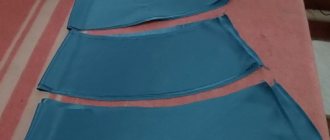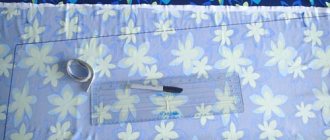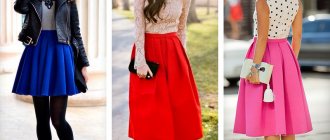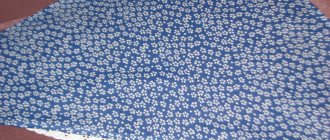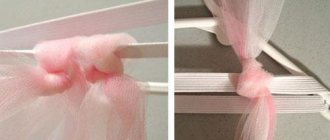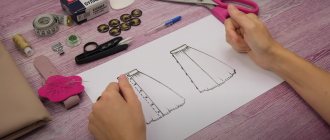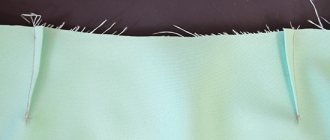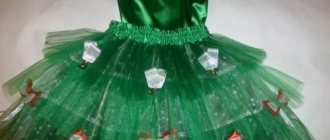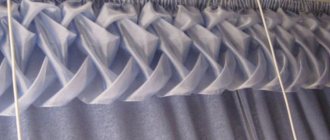Fatin - what is it?
Tulle is a lightweight mesh material of varying hardness, which is used both for sewing clothes and for decorating rooms for special events.
In addition, the material is often used in sewing children's clothes, and it is also used to make clothes for dolls. This unique and spectacular translucent material perfectly holds its shape and volume, both at rest and during movement. The composition of tulle includes high-quality and thin nylon threads. They give the material airiness, elasticity and strength. Among textile materials, tulle is the most popular type.
The main advantages of the material include:
- ease;
- airiness;
- elasticity, thanks to which it lies in lush flounces and large folds;
- crease resistance;
- resistance to deformation;
- maintaining the silhouette even after getting wet;
- moisture resistance;
- wear resistance;
- resistance to pollution;
- low maintenance requirements.
Despite the fact that tulle has many advantages, it also has disadvantages. The main ones are that the material tends to become electrified and stick to the body. And also the fact that products made from multi-layer tulle do not allow air to pass through well.
After its appearance, tulle was produced only in white. Subsequently, thanks to the development of technology, bright colors began to appear.
According to the degree of hardness, tulle can be:
- hard - holds its shape perfectly and is extremely hard. This material is used to make decorations for halls, fashion accessories, interior items and car decorations, as well as protective insect nets;
- medium – has optimal density. Decorative items, artificial flowers, petticoats are made from it;
- soft – the material is soft and is used for sewing wardrobe items;
- Eurofatin is a soft and delicate material with a matte surface. When it comes into contact with the skin, it evokes only positive emotions. Fashionable American skirts and other products are made from it;
- spandex tulle - this material contains an elastomeric spandex thread, which makes the fabric elastic and stretchable.
Tulle is mainly used for sewing shocking and romantic costumes, as well as stage outfits, dance skirts and ballet tutus. In addition, tulle is very often used for sewing skirts for girls. Products made from this material have a feminine and harmonious appearance.
How to choose tulle for a children's skirt
Experienced seamstresses recommend paying attention to material of medium and weak rigidity. Too coarse tulle is uncomfortable to wear, and unfinished edges can leave scratches on children's skin. In addition, hard material is heavier than soft material.
The table shows the parameters of the fabric suitable for sewing a skirt:
| Kinds | Density |
| Soft | 18 g/m2 |
| Standard | 19 g/m2 |
| Stretch tulle | 20 g/m2 |
| Medium hardness | 18.5 g/m2 |
The best material for children's tutu skirts is considered to be eurofatin (19 g/m2).
It has a smooth, silky texture. Light, delicate, pliable, easily folded and smoothed out. The width of the fabric in a roll corresponds to a single standard - 3 m. This allows you to sew a skirt without unnecessary joints. You can buy fabric with a printed pattern, embroidery or beads. Then the children's skirt will look festive and unusual.
Model selection
Feminine and weightless tulle skirts differ in their cut and length. Before you start sewing, you need to decide on the style, since not every model is easy to make. Types of skirts:
- The tutu is short, consists of several layers of semi-rigid tulle, sewn to a belt or elastic band.
- A tulle chopinka is an elongated model, sewn from one or several layers of soft material. The cut is rectangular, wedges, “sun” or “half-sun”.
- Tutu – strips of tulle that are attached to an elastic band or belt (without sewing).
- American or Pettiskirt is a combination of a tutu skirt and a sun pattern, creating a very fluffy product.
- With large frills - during manufacturing, strips of fabric are gathered and sewn onto the lining in tiers.
It is better for inexperienced craftswomen to start with such simple models as tutu and American.
By length, tulle skirts are divided into:
- super-mini (very short, worn with leggings);
- mini (above the knee);
- knee-deep;
- midi (below the knee);
- maxi;
- with differences in length.
Many people wonder how to find a model and how to sew a tulle skirt that will look good on its owner. First of all, you need to determine your body type, and also take into account your height, age, and build. Stylists' recommendations:
- Those with a pear-shaped figure need to choose a style so that excessive fluffiness does not weigh down the hips. A long Chopin skirt made of one or two layers of tulle with lining will look good.
- Short curvy models are also not suitable for an apple-shaped figure. It is better to stay with a moderate midi version. In this case, the waist can be slightly raised and emphasized with a belt.
- A full skirt will visually balance the “inverted triangle” figure. It will distract attention from the massive shoulders and give the hips the missing volume.
Very short curvy models are suitable for little girls and slender young girls who often use super minis for sports and dancing.
The length for young slender women can be any. As for overweight ladies, not every style of tulle skirt will suit them. It is better to choose a one-layer option with a lining. The length depends on height; knee-length, midi or maxi skirts are preferred.
Skirts with a difference in length are suitable for special occasions. As a rule, these are models with a train and a short front. They look spectacular at weddings, parties, and other celebrations. For convenience, the train can be made removable. It should be sewn from a softer tulle than the main product, so it will flow and fall beautifully.
Measurements and calculations
To understand how much tulle is needed to sew a product, you should make some calculations and measurements. Much depends on the chosen model. If a craftswoman plans to sew a rectangular-cut tulle skirt with her own hands, she needs to know the length of the product. For example, for a pack 60 cm long, you will need a piece of material 3 m wide. The length of the fabric is 2.40 m (the length of the item multiplied by 4). This fabric will make 4 layers of 3 meters each, or 2 layers of 6 meters. Both options will be quite lush. But if the waist circumference is more than 75 cm, then in order to get a pronounced gather and tails, it is better to take layers of 6 meters.
If the fabric is thin and very see-through, it is worth adding a petticoat in the same color. The material should be smooth, giving a beautiful drapery. To add extra airiness, you can use thick fabric for the petticoat. If, on the contrary, the volume is required to be minimal, the material should be soft. With a fabric width of 1.5 m, you will need a cut whose length is 5 cm less than the length of the skirt.
A petticoat is needed in products made of very thin material with a small number of layers. It also serves to ensure that the edge of the hard tulle does not cling to the tights. It is calculated and cut in the same way as for a pack.
For a shopenka consisting of several layers cut in a “sun” pattern, the calculation of tulle depends on the number of layers and the length of the product. To cut out one of the elements, you will need a square, the side of which is calculated using the formula: (length of the item + waist circumference, divided by 6.3) x 2. Thus, with a waist circumference of 70 cm and a skirt length of 60 cm, for 1 layer you need a cut with a side (60+70/6.3) x 2, that is, approximately 142 cm.
If you plan to make your own tulle skirt with an elastic band that is worn through the bottom, then you need to take into account the girth of the hips, not the waist. That is, for a shopenka 60 cm long, consisting of 4 layers, you will need 3 m of fabric with a width of 3 m, and for six layers - already 4.5 meters. To make this model gather at the waist, you need to either increase the waist circumference, or use a “double sun” cut, when the resulting parts are cut and sewn in pairs.
To sew a fluffy three-tiered skirt with large frills, you will need 4.5 meters of tulle and fabric for the base, the length of which is 5 cm shorter than the length of the product.
To make a children's tutu skirt without sewing, you need to take strips of tulle 15-20 cm wide. The number of parts is equal to the waist circumference in centimeters. You can take a little more to increase the pomp and reduce transparency. The length of the strips is equal to twice the width of the product. To calculate how much tulle is needed for a thing, you should count the number of vertical elements. For example, for a tutu skirt 30 cm long with a fabric width of 3 meters, you will need a 3 meter long piece. This piece will make 75 strips measuring 60 x 20 cm.
Required Tools
It will be very easy for a novice seamstress to work with this material, as it is easy to process. But it is recommended to prepare some tools first. In addition to pieces of fabric of the required size, you will need:
- centimeter tape for measurements;
- scissors;
- pins for chopping parts;
- needle;
- threads in the color of the fabric;
- elastic band (for a tutu skirt you can use a checkerboard one, which is used to make hairbands);
- satin ribbon for decorating the belt.
You also need to prepare your sewing machine by installing a needle for thin and stretch fabrics. If you plan to process the bottom, you will need bias tape.
Some types of tulle shrink. To avoid this, and at the same time eliminate all creases, you should steam the fabric with an iron before sewing.
What makes a children's skirt different from an adult's? Basic sewing rules
A do-it-yourself tulle skirt, a master class and a detailed process for making an adult product look like this:
- On tracing paper you need to carefully draw a double semicircle. Both semicircles have a meaning: the first corresponds to the size of the waist circumference, and the second indicates the length of the future product.
- The next stage is to carefully cut out the template with scissors.
- Next, you need to fold the fabric so that you end up with 8 layers. This is done simply: first, the material is folded in half, then in four, and the last stage is 8 layers.
- Use pins to secure the fabric along the edges of the gather.
- Cut out the template.
- The result should be 4 even circles with a hole inside. Place the resulting parts on top of each other and secure with needles or pins in the waist area: front, back and sides.
- Connect the ends of the elastic band and sew them together.
Product assembly:
- Place the fabric on the inside of the elastic band and machine sew along the entire radius.
- In a triangular shape, cut out tulle weaving for the cover.
- Be sure to finish the top edge of the product with a basting stitch and tighten the thread so that the tubular cover sits well on the waist.
- The bottom tulle layer is secured to the lining material. The excess that is visible from the hem needs to be trimmed off.
It’s even easier and faster to sew a children’s tulle skirt with your own hands.
A product master class for a little fashionista looks like this:
- Cut tulle ribbons 10 cm wide, maybe a little narrower. Their length should be 2 times longer than planned.
- Take a wide, thick elastic band and connect its edges.
- You need to tie ribbons folded in half to the rubber base. It is inconvenient to do this procedure while hanging, so it is better to pull the elastic band over the back of the chair.
- Attach the pieces of tape in a circle until all the free space is filled.
At this point, the technical process of sewing a classic tulle skirt is considered complete. If desired, the outfit can be decorated with various decorative elements.
Master class: tulle skirt without a sewing machine for a girl
A tulle skirt for a girl can be assembled without a single seam. Such models are called a tutu skirt or a tutu skirt. They turn out lush, airy, reminiscent of the hem of a Disney princess dress.
There are several assembly options. You can make a short skirt with sharp edges sticking out in all directions, or cut the hem evenly so that it resembles a bell flower. Long models are made smoother, but this does not make them lose their attractiveness and luxury.
Mini
What materials are needed to assemble a short skirt without sewing:
- elastic tape with checkerboard weave;
- tulle in 2 matching colors;
- satin ribbon;
- tape measure;
- scissors;
- crochet hook number 5.
The only seam you need to make will be on the elastic. You should measure the required length and subtract 2-3 cm (depending on the elasticity of the tape). This is necessary so that the skirt does not fly off the belt.
The roll of tulle is unrolled and the required amount of fabric is measured. It is necessary to cut strips 5-10 cm wide and 2 times longer than the expected length of the product. It is better to cut the fabric lengthwise. Eurofatin almost does not stretch in this direction.
If the style of the skirt is planned with a straight, even hem, then the material is cut into rectangles. If you need sharp ends, then fold each rectangle in half, and cut off the corners, making one, sharp in the center.
The rubber band is put on a mannequin; if there is no such thing, then you can use a thick book, cutting board or the back of a highchair. The main thing is that the tape has natural tension. It wasn't completely stretched, but it didn't sag either.
The tulle strip is folded in half. At the fold, a loop of fabric is formed, which must be inserted into one of the holes in the elastic. This is done using a crochet hook. The first row of elastic is skipped.
In the second, from the connecting seam, count 5-7 holes and thread the tulle. You need to pull out a small loop of material (3-5 cm) and pass the free ends through it. There is no need to tighten it too much.
Then skip 5-7 cells in the same row and repeat these steps. You can thread different colors of tulle one by one, or complete the entire row with one shade of fabric, and the next with another.
To start weaving the second line, you need to skip one checkered row of elastic at the top and thread the tulle into the next one. Now you need to insert strips of fabric so that they form a checkerboard pattern with the bottom row. If the gap between the ribbons was 7 squares, then the strip of the second row should be threaded into the fourth and sag between the two lower ones.
In this way you need to knit the entire elastic band, adding new rows. The more new lines, the fuller the skirt will be. When the weaving is completed, the tulle strips are carefully straightened. At the front you need to tie a bow made of satin ribbon; to do this, insert a hook into one of the middle rows, into a knot of fabric, and carefully pull the ribbon through. Tie a knot, and then make a regular bow.
The tulle tutu skirt for the girl is ready. This short model is suitable for everyday wear and for holidays. Creates a fun and vibrant look. Can be worn with white socks, shoes, sandals or sneakers.
Long skirt
Creating a long skirt is almost no different from the previous method.
What materials will be needed:
- tulle;
- scissors;
- wide elastic band;
- tape measure.
For this model, it is not necessary to choose a checkerboard elastic band. You can buy a regular elastic band, 5 cm wide. Measure the required length and reduce it by 2-3 cm, carefully sew the elastic into a ring, straighten it and put it on a solid base for ease of work.
A long tulle skirt for girls is perfect for special occasions
Even strips are cut from the tulle. The length of the skirt must be multiplied by 2, this will be the length of the rectangle. The width of the tape can be from 7 to 12 cm. Each strip is folded in half and the folded end is inserted under the elastic band. Thread the hanging fabric into the extended loop and carefully tighten it, placing the knot at the bottom.
These steps are repeated until the tulle completely covers the elastic. Then the loops are carefully moved towards each other and the resulting gap is closed. You need to tie them on an elastic band for so many years that they cannot move freely. The ends of the tulle are carefully straightened, and the skirt can be considered ready.
These models are suitable for the holidays. Look good with sandals or sneakers. Create a stylish and elegant look. They emphasize girly tenderness and give the image a romantic look. Recommended to wear with light cotton shorts.
Decorating the product
Weightless tulle items look elegant in themselves, so for everyday wear you don’t need to add decorations. But if they are intended for a holiday, then there are several ways to decorate the products to give them shine and showiness. The belt can be decorated with a wide satin ribbon, which is tied at the back or side with a lush bow. The latter can be replaced with an artificial flower or brooch. All these decorations can be used without a satin belt.
The hem is also decorated with ribbon or trim to emphasize the volume. You can insert fishing line inside the fabric to create beautiful folds along the edge. If desired, the hem is embroidered with beads, seed beads, sequins, and decorated with decorative embroidery. Children's skirts are complemented with beautiful buttons, bows, pompoms, and lace.
Seamless tulle skirt
To make the skirt fluffy and voluminous, you will need a large piece of tulle - from 10 m. To it - a strip of dense fabric of a matching color, 13-15 cm wide and 8-10 cm longer than the waist circumference. And also a wide long ribbon around the waist with allowances for ties - it will be used instead of an elastic band.
Mark and cut all the tulle into strips of approximately 17-20 cm. Take one strip, fold it in half and tighten it with a loop knot on the ribbon, as shown in the photographs. Repeat this with all the cuts - the more of them and the tighter they are, the fuller the skirt will be. After this, you can leave the skirt like this with ties at the ends or sew on an even belt made of thick fabric to match.
Seamless skirt with checkerboard elastic
This tulle skirt is similar to the previous one, but instead of a ribbon you will need a wide checkered elastic band. Do not tie tulle ribbons through the top, but pull them through the elastic holes. To make it more convenient to work, first stretch it and fix it, for example, on a book.
Thread the tulle strips into the second row - if you leave them very low, they may come out over time. When the elastic ends, the first layer of the seamless pack is ready. But you can always make it more voluminous: just repeat all the manipulations, but for the third row of holes, helping yourself with a pen or any other thin object.
Seamless skirt
You will need:
- At least 10 meters of tulle about 120cm wide
- A strip of fabric, the length of which is equal to the circumference of your waist + 10 cm, and the width is approximately 13 cm.
- A wide ribbon, the length of which is equal to the circumference of your waist + ties.
Operating procedure:
Lay out a roll of tulle on the table.
Measure 18cm from its outer edge and mark this point.
Continue making marks every 18cm until you reach the opposite edge of the cut.
Using the marks as a guide, cut the fabric into strips.
Take the strips one at a time and, folding them in half, tie them to the tape as follows:
The closer the knots are, the fuller the skirt will be. Continue until you have filled the entire tape.
Tie the ends of the ribbon.
You can leave the skirt as is, using the ends of the ribbon as ties each time you wear it, or you can create a belt that will better define your waist and hide the knots.
Fold the strip of fabric you chose for the waistband in half and mark its center.
Do the same with the skirt - mark its middle.
Connect the fabric and the skirt at the marked points.
Next, continue pinning the edge of the fabric with knots along the entire length of the skirt's waistband.
Flip the skirt over and place a basting stitch just under the knots, catching the edge of the fabric that is now underneath, on the table side.
Hem the unsewn edges of the fabric on all sides.
Continuing this topic, watch this video, which presents three more options for creating a seamless skirt:
Fashion trends
The tulle skirt is light and delicate, it can be combined with a wide variety of elements of your wardrobe.
You can wear a top, a T-shirt, a blouse and all this will look extremely beautiful. It will be very difficult to find an identical model of a skirt in a store that you make with your own hands, so such needlework may interest you. After the first successful execution of your plan, it will be much easier for you to work with both tulle and other materials. It is recommended to use patterns with which you can cut out all the details for the future product. Think in advance about the style of the skirt, whether accessories and other components will be used. The combination of such products will always be interesting and in demand. All modern fashion trends are directly related to tulle, as it is truly beautiful and interesting to fashion designers.
The advantage of a tulle skirt is that it goes well with sneakers, shoes, ballet flats and even flip flops
The most important thing is that you feel comfortable. You can also make a tulle skirt for your daughter.
In this case, everything is also done according to a pre-developed plan, only the appropriate length is taken.
The nuances of tailoring taking into account the model
The material consumption and tailoring of skirts of different styles differ. You need to carefully study the information on how to sew a fluffy tulle skirt, using different methods. It is also recommended to familiarize yourself with the advice of experienced seamstresses.
Tutu for baby
To sew a tutu skirt for a girl, you will need a piece of tulle 5 m long and 2 times wider than the expected length of the tutu. You also need lining fabric, an elastic band 2 cm wide (its length is 1-2 cm less than the waist circumference), thick knitwear 25 cm wide (the length is equal to the waist circumference + 2 cm). Manufacturing sequence step by step:
- Cut the tulle into rectangles 50 cm long, fold them in half to make a length of 25 cm.
- Using a special gathering foot, sew all the folded pieces of fabric, stepping back from the fold 5 mm, placing them one after another. The seam should be laid with wide stitches and a loosened thread.
- Gently pulling the thread from one side, assemble all the parts so that the total length is equal to the waist circumference + 5-10 cm
- Sew the piece along the side seam.
- Cut out a piece of fabric for the lining. Its length should be slightly less than the length of the overskirt.
- Sew the fabric along the side seams and gather it in the same way as tulle.
- Place the lining in the skirt and baste.
- Cut out a belt from knitwear of such a size that it coincides with the circumference of the resulting skirt and a width equal to the width of the finished belt, multiplied by 2.
After this, you can sew the belt to the top of the skirt from the inside, then bend it in half and, having folded it in, sew the front side to the tulle with a zigzag seam. Insert the elastic and sew the ends together. Sew the sides of the waistband with hidden stitches.
Cut tulle to measure
Sew each piece of fabric individually
Pull the thread to gather the fabric
Sew all the parts together
Sew on ribbon
American
Sewing a tulle skirt for a girl with your own hands will require a lot of effort, but the result is spectacular. For the “patty” model, you need to prepare material for the tier and frills, thick fabric for the yoke, elastic, and sewing accessories. Stages of work:
- From dense material, cut out a yoke, the length of which is equal to the waist circumference multiplied by 2, and the width is 20 cm.
- Use tulle to form a skirt tier, the length of which is equal to the waist circumference multiplied by 9, with a width of 11 cm.
- For ruffles, you need to cut long strips of tulle 7 cm wide.
- Along the strips exactly in the middle you need to lay a machine stitch for assembly. You can use a special foot. While sewing, add the following strips.
- After this, pull the ruffles until their length is equal to the length of the tier.
- Sew ruffles to the edge of the tier.
- Sew the rectangle for the yoke along the short side into a tube, bend the top edge and form a drawstring.
- Gather the tier to the length of the yoke manually or using a machine stitch and sew to its lower edge. Insert an elastic band into the drawstring.
To make a girl's skirt look more elegant, you can decorate it with a satin ribbon and tie it in a bow.
Sew the ribbons and pull them together to create ruffles.
Sew the resulting ruffles to the front side of the rectangle
Fold the yoke in half and sew the ends together, closing the circle
Sew tiers onto the yoke
Ready product
How to sew a multi-layer tulle skirt for a girl (the easiest way)
You want to be a princess at any age, and if your desire does not go against fashion, then it simply must come true. Today a tutu can be worn with anything - with a knitted sweater, with a biker jacket or with a light T-shirt. For variety, you can sew a full tulle skirt of different lengths using simple step-by-step instructions.
You will need:
- tulle of the desired color;
- thin knitted fabric for the cover;
- threads, scissors, pins;
- satin ribbon;
- sewing machine.
Operating procedure:
- From knitted fabric, cut out and sew a cover for the future skirt. The length of the cover should be 10 cm shorter than the length of the finished skirt.
- Cut out 3 types of stripes from tulle. The length of all stripes is the same and can be 3-5 times greater than the circumference of the hips (it all depends on how full the skirt you want). The width of the first strip should be equal to the length of the product, the second strip should be 10 cm shorter than the first, and the third should be 10 cm shorter than the second.
- Run a wide machine stitch along the edge of the widest strip, pull it to the desired width and sew it to the cover, leaving 2-3 cm free from the top.
- Pull the second layer together and sew it on top of the first, and do the same with the third.
- Sew an elastic satin ribbon along the top edge - this will be the belt of the product. You can decorate the belt with a bow, and the layers of tulle with rhinestones or beads.
The finished skirt can be sewn to a knitted sweater to create a fashionable dress. But first, take an interest in how to sew knitted parts, as well as sew other types of fabric to them.
Rectangle skirt
Fabric calculation. A rectangular skirt is the most economical option. In this style, only two parameters appear: the desired number of layers and the expected density of each layer.
The following options are possible:
- Double layer. Both layers are six meters wide. Length is optional.
- Three-layer. Each layer is three meters wide. Length is optional.
- Three-layer. The first and second layers are six meters each, the bottom one is three meters. Length is optional.
- Three-layer. The top one is nine meters, the middle one is six meters, the bottom one is three meters. Length is optional.
- Four-layer. All layers are three meters wide. Length is optional.
In accordance with the chosen style, calculations can be made.
Important! First, it is better to decide on the choice of tulle, since the width of the fabric varies greatly among different manufacturers - from 1.50 cm to 3 m.
Sun
To sew a tulle skirt for a girl or an adult woman, you need from 4 to 8 layers of fabric. If there are fewer of them, you will need lining and gathers at the waist for volume. Then we calculate the radius for the hole in the circle using the formula: waist circumference / 3.14. Each of the layers is assembled separately, since otherwise they will repeat the shape of each other, and there will be no volume. To save material, you can cut out some of the circles whole, and some from halves and quarters, which are then sewn together. It is better to place such layers at the bottom.
An interesting option is obtained if you cut out a sun skirt from tulle in 2-3 layers and wear it with other clothes. It can be worn on top to add elegance to the look, or worn down to create volume. In order to sew such a piece of clothing, we take 2 m of medium-hard Euro tulle, elastic tape around the waist and sewing accessories.
Sewing is carried out as follows:
- Cut out the required number of circles for the circle skirt. The hole in the center should be equal to the circumference of your hips for easy donning.
- Place the layers together and machine stitch them close to the edge.
- Fold the elastic band in half and iron it to prevent shrinkage.
Then we process the belt with trim. Pull it slightly and sew the elastic along the edge, hiding the previous seam. We sew the ends of the binding together.
Pattern
Fold the tulle in half and cut out the required number of pieces
Place the resulting round blanks together and stitch
Sew on an elastic band
Ready product
The main stages of making a shopinka
This skirt is based on rectangle, half-sun, sun and double-sun cuts. The most luxurious item made from this material will be in the latter case, and this will also help to avoid excess volume at the waist. How to sew a tulle shop skirt 60 cm long with your own hands - beginning needlewomen should learn about this.
To make this model, you need to know the length of the product and waist circumference. You will need to cut out 4 layers of material, each of which consists of two sun circles. Fabric consumption for this model: a piece of tulle 6 x 3 meters, a piece of material for the lining measuring 1.45 x 1.45 m. In addition, you need to prepare a double coat for the belt, sewing accessories, pins, and a zipper.
Creating patterns and cutting tulle
First of all, a semicircle pattern is made. To do this, two radii are laid out on paper (wallpaper will do) from one point. The first is equal to the waist circumference divided by 6.3. With a waist circumference of 70 cm, the radius will be equal to 12 cm. The second radius is equal to the first + skirt length + 3 cm for seams and hems. In our case, it will look like this: 12 + 60 + 3 = 75. The result will be a semicircle with a diameter of 150 cm.
After this, the tulle is divided into 8 equal squares measuring 1.5 x 1.5 m. Each of the elements must be folded in half and, using a pattern, cut out a circle with a hole inside. If the size of the fabric does not allow you to cut out each piece from a square, you need a more economical layout. For such a case, there is a chess pattern principle:
- We fold the material in half lengthwise, aligning the edges.
- The semicircle is applied with the flat side to the fold, and the outline is outlined. After cutting, you will get a solid semicircle.
- Then the pattern is shifted and transferred with the flat side to the opposite side, without bending.
- Here you will get two half-suns that will need to be sewn together. The pattern is shifted and turned over until all layers are cut out.
You can move not the pattern, but the fabric, after gluing the pattern to the floor with tape. Through the transparent tulle its contours will be clearly visible.
Next you need to do the following:
- Cut each circle in one place along the radius.
- Cut a circle from the lining fabric in the same way as from tulle, 5 cm shorter.
- Cut out a belt with a length equal to your waist circumference and a width of 8 cm.
- Glue it with double tape. If you plan to replace the belt with an elastic band, then you do not need to cut out this part. In this case, you should prepare an elastic band, the length of which is equal to the waist circumference minus 2 cm.
In the case when the “sun” cut is taken as the basis, additional volume can be added to the shoppenka by increasing the size of the waist opening. Each layer in such a skirt can have its own gather factor due to different diameters of the waist opening. The thickest gathering is done on the top layer of tulle, while the bottom layer remains unchanged.
Opening radii for a skirt consisting of a different number of layers for a waist of 70 cm:
- The bottom (first) layer is coefficient 1, that is, radius = waist circumference /6.3, approximately 11.5 cm.
- The top layer is a coefficient of 1.5, which is considered the base layer for the assembly. The radius of the hole will be 70 x 1.5/6.3, that is, approximately 17 cm.
- If there are 3 layers, then the middle one can be taken with a coefficient of 1.25. This will be 14 cm.
- If there are 4 layers, the coefficients can be taken, for example, 1; 1.2; 1.4; 1.6. It depends on how full the skirt is needed.
In the fabric departments you can find tulle with decorative elements. This will significantly save time, since you will not need to think about how to decorate the product.
Pattern
The fabric needs to be folded
The fabric for the lining should be cut to the width of your hips.
Product assembly
First of all, you need to combine two cut circles and sew them along one side seam. You will get 4 double suns. Two of them are combined along the waist section and pinned together. Along the top of each of the two resulting parts, 2 parallel machine lines are laid with a loose thread and a large stitch.
Then you can start assembling:
- By pulling the threads on one side of the stitches, we gather the parts so that their length is equal to the waist circumference. Baste and sew both parts together along the waist line.
- We cut the circle of lining fabric along the radius, place it under all layers of tulle, baste it and sew it at the waist. We remove all the basting lines.
- We place the belt with the front side on the front side of the skirt and sew along the waist line.
- We sew all the layers along the side sections using an overlocker to make it easier to sew in a zipper.
- Using pins, pin the zipper to the side seam so that its upper teeth reach the middle of the waistband.
- We bend the belt to the wrong side, baste it and attach it to the skirt, bending the edge.
At the very end, sew the side seam below the zipper. We process the bottom of the lining with an overlock or hem stitch with a closed cut. The four-layer tulle shopinka skirt is ready.
Processing secrets
Tulle is sewn with a zig-zag seam: stitch length 2 mm, width 1.5. There is no need to process the bottom - it does not crumble.
Each panel is assembled separately. Departing 0.7 cm from the top cut, machine stitching is done, setting the largest stitch pitch. Then lay a second line - 1 cm below the first. Leave long ends of the threads, which are carefully pulled together.
How to decorate a classic tulle skirt
To give a tulle skirt a more elegant look, you need to decorate it.
For this you can use:
- satin ribbons;
- shiny rhinestones;
- beads;
- artificial flowers;
- decorative bows;
- sparkles.
You can place the decoration anywhere, both below and throughout the skirt. For example, the bottom of the skirt can be decorated with rhinestones or sequins in the form of flowers. Using beads and beads, you can lay out an inscription or design.
A tulle skirt made with your own hands will bring more joy than a purchased one. A detailed master class will help turn any idea into reality.
It doesn’t matter which model is chosen for sewing. The main thing is that the work put in will bring pleasure to the needlewoman, and those around her will be able to fully enjoy the beauty of such an airy skirt.
Required materials and tools
To make a product to size, you need to measure your waist circumference and desired length. For this purpose you need a centimeter. Based on the layering of the skirt, we select the required amount of tulle. The more layers, the more material.
There is nothing difficult to sew a tulle skirt with your own hands
Also, fabric will be useful for work, which will serve as a lining. It is best to use an atlas.
If the model requires an elastic band, then it is better to purchase two options at once: thin and wider. The elastic should be given special attention, since it is its density and quality that determines how well the skirt will hold at the waist.
The following auxiliary materials will be useful:
- scissors (it is important that they are sharp enough);
- ruler;
- pins for fixation;
- for cutting: paper, a piece of soap for tracing and a pencil;
- threads (it is better to immediately match them to the tone of the product);
- sewing machine;
- tracing paper
Photo of a tulle skirt
Sources
- https://ld58.ru/v-garderobnoj/fatinovaya-yubka-dlya-devochki.html
- https://odezhda.guru/yubki/kak-izgotovit/2633-ubka-iz-fatina-svoimi-rukami
- https://lifegirl.ru/skirt-of-tulle-with-their-hands-master-class.html
- https://lafoy.ru/yubka-iz-fatina-svoimi-rukami-6-idey-foto-482
- https://www.promyhouse.ru/rukodelie/shite/yubka-iz-fatina-svoimi-rukami.html
- https://www.joxin.club/rukodelie/krojka-i-shite/yubka/iz-fatina.html
- https://tytmaster.ru/yubka-iz-fatina-svoimi-rukami/
- https://vsesvoimirykami.ru/kak-sshit-yubku-iz-fatina/


